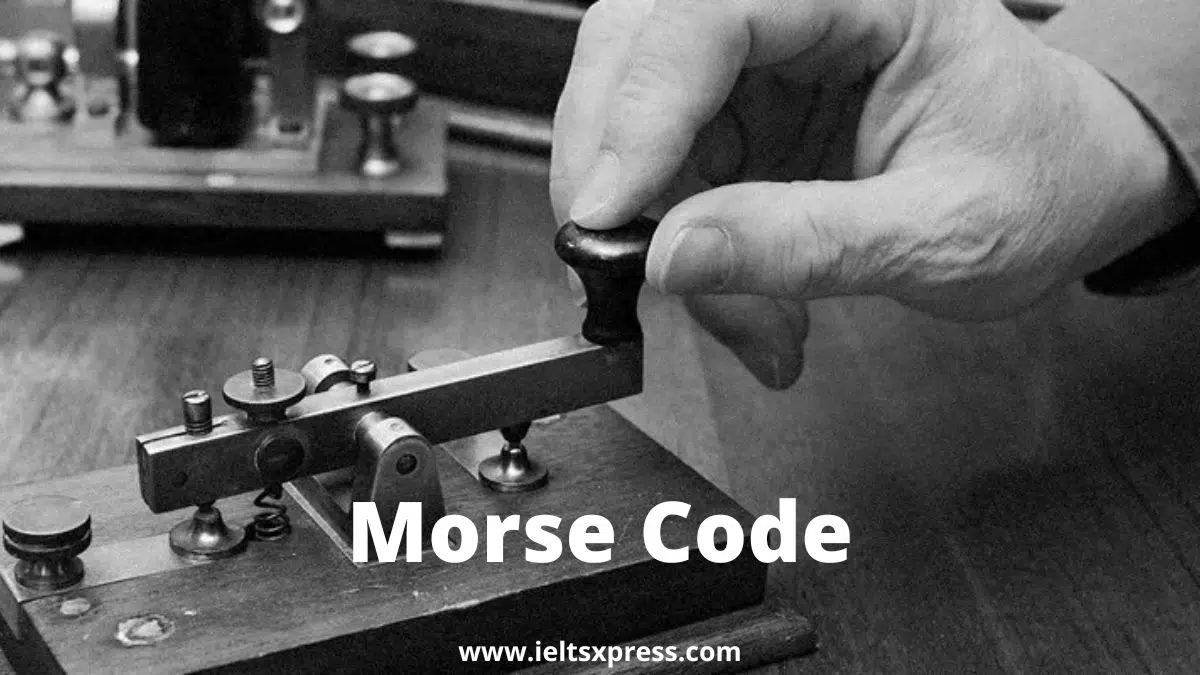Morse Code IELTS Reading Academic Passage with Answers
Reading Passage 1
Real IELTS Exam Question, Reported On:
| India | 11th June 2022 |
Morse Code
A.
Morse code is being replaced by a new satellite-based system for sending distress calls at sea. Since 1992 countries around the world have been decommissioning their Morse equipment with similar (if less poetic) sign-offs, as the world’s shipping switches over to a new satellite-based arrangement, the Global Maritime Distress, and Safety System. The final deadline for the switch-over to GMDSS is February 1st, a date that is widely seen as the end of an era. For although dots and dashes will not die out altogether — they will, for example, continue to be used by amateur radio operators, spies, and some members of the armed forces — the switch to GMDSS marks the end of the last significant international use of Morse.
B.
The code has, however, had a good history. Appropriately for a technology commonly associated with radio operators on sinking ships, the idea of Morse code is said to have occurred to Samuel Morse while he was on board a ship crossing the Atlantic. At the time, Morse was a painter and occasional inventor, but when another of the ship’s passengers informed him of recent advances in electrical theory, Morse was suddenly taken with the idea of building an electric telegraph. Other inventors had been trying to do just that for the best part of a century. Morse succeeded and is now remembered as the father of the telegraph partly thanks to his single-mindedness — it was 12 years, for example, before he secured money from Congress to build his first telegraph line — but also for technical reasons.
C.
Compared with rival electric telegraph designs, Morse’s design was very simple: it required little more than a ‘key’ (essentially, a spring-loaded switch) to send messages, a clicking ‘sounder’ to receive them, and a wire to link the two. But although Morse’s hardware was simple, there was a catch: in order to use his equipment, operators had to learn the special code of dots and dashes. Originally, Morse had not intended to use combinations of dots and dashes to represent individual letters. His first code, sketched in his notebook during that transatlantic voyage, used dots and dashes to represent the digits 0 to 9. Morse’s idea was that messages would consist of strings of numbers corresponding to words and phrases in a special numbered dictionary. But Morse later abandoned this scheme and, with the help of an associate, Alfred Vail, devised the Morse alphabet, which could be used to spell out messages a letter at a time in dots and dashes. At first, the need to learn this complicated-looking code made Morse’s telegraph seem impossibly tricky compared with other, more user-friendly designs. For example, Cooke and Wheatstone’s telegraph used five needles to pick out letters on a diamond-shaped grid. But although this meant that anyone could use it, it also required five wires between telegraph stations. Morse’s telegraph needed only one.
D.
As electric telegraphy took off in the early 1850s, the Morse telegraph quickly became dominant. It was adopted as the European standard in 1851, allowing direct connections between the telegraph networks of different countries. (Britain chose not to revise to allow for accents and other foreign more years) . By this time, Morse code had been involved, sticking with needle telegraphs for a few characters, resulting in a split between American and International Morse that continues to this day.
E.
On international submarine cables, left and right swings of a light beam reflected from a tiny rotating mirror were used to represent dots and dashes. Meanwhile, a distinct telegraphic subculture was emerging, with its own customs and vocabulary and a hierarchy based on the speed at which operators could send and receive Morse code. First-class operators, who could send and receive at speeds of up to 45 words a minute, handled press traffic, securing the best-paid jobs in big cities. At the bottom of the pile were slow, inexperienced rural operators, many of whom worked the wires as part-timers. As their Morse code improved, however, rural operators found that their newfound skill was a passport to better pay in a city job. Telegraphers soon swelled the ranks of the emerging middle classes. Telegraphy was also deemed suitable work for women. By 1870, a third of the operators in the Western Union office in New York, the largest telegraph office in America, were female.
F.
In a dramatic ceremony in 1871, Morse himself said goodbye to the global community of telegraphers he had brought into being. By the time of his death in 1872, the world was well and truly wired: more than 650,000 miles of telegraph line and 30,000 miles of submarine cable were throbbing with Morse code, and 20,000 towns and villages were connected to the global network. Just as the Internet is today often called an ‘information superhighway,’ the telegraph was described in its day as an ‘instantaneous highway of thought.’
G.
But by the 1890s, the Morse telegraph’s heyday as a cutting-edge technology was coming to an end, with the invention of the telephone and the rise of automatic telegraphs, precursors of the teleprinter, neither of which required specialist skills to operate. Morse code, however, was about to be given a new lease of life thanks to another new technology: wireless. Following the invention of radiotelegraphy by Guglielmo Marconi in 1896, its potential for use at sea quickly became apparent. For the first time, ships could communicate with each other, and with the shore, whatever the weather and even when out of visual range. In 1897 Marconi successfully sent Morse code messages between a shore station and an Italian warship 19km (12 miles) away. The first sea rescue after a distress call sent by the radiotelegraph took place in 1899 when a lightship in the Dover Straits reported the grounding of the Elbe, a steamship.
Questions 1-7
Reading passage 1 has seven paragraphs, A-G.
Choose the correct heading for paragraphs A-G from the list of headings below.
Write the correct number, i-x, in boxes 1-7 on your answer sheet.
List of Headings
i Standard and variation for the code
ii Substitution for Morse code
iii Emergence of many employment opportunities
iv The advantages of Morse’s invention
v Discovery of electricity
vi Sea application of Morse code expanded under new technology
vii The invention of Morse code
viii The need for radio operators
ix International reach of Morse code
1. Paragraph A
2. Paragraph B
3. Paragraph C
4. Paragraph D
5. Paragraph E
6. Paragraph F
7. Paragraph G
Questions 8-12
Do the following statements agree with the claims of the writer in Reading Passage?
In boxes 8-12 on your answer sheet, write.
TRUE if the statement is True
FALSE if the statement is false
NOT GIVEN If the information is not given in the passage
8. Morse had already been famous before the invention of code.
9. Morse waited for a long time to receive support from Congress.
10. Compared with other designs, the learning experience of Morse code is demanding
11. Many big cities prefer to employ rural operators.
12. Morse died from overwork.
Also Check: Animal minds Parrot Alex IELTS Reading Academic
Morse Code IELTS Reading Answers
Practice with Expert IELTS Tutors Online
Apply Code "IELTSXPRESS20" To Get 20% off on IELTS Mock Test
1. II
2. VII
3. IV
4. I
5. III
6. IX
7. VI
8. NOT GIVEN
9. TRUE
10. TRUE
11. FALSE
12. NOT GIVEN
Morse Code IELTS Reading Answers Explanation
Question 1
Answer: ii
Question type: Matching Headings
Answer location: Paragraph A
Answer explanation: Paragraph A illustrates, “Morse code is being replaced by a new satellite-based system for sending distress calls at sea. Since 1992 countries around the world have been decommissioning their Morse equipment with similar (if less poetic) sign-offs, as the world’s shipping switches over to a new satellite-based arrangement, the Global Maritime Distress, and Safety System. The final deadline for the switch-over to GMDSS is February 1st, a date that is widely seen as the end of an era.” These lines reveal the substitution for morse code. Hence, the answer is ii.
Question 2
Answer: vii
Question type: Matching Heading
Answer location: Paragraph B
Answer explanation: Paragraph B states, “Appropriately for a technology commonly associated with radio operators on sinking ships, the idea of Morse code is said to have occurred to Samuel Morse while he was on board a ship crossing the Atlantic. At the time, Morse was a painter and occasional inventor, but when another of the ship’s passengers informed him of recent advances in electrical theory, Morse was suddenly taken with the idea of building an electric telegraph.” These lines indicate how the morse code was invented. Thus, the answer is vii.
Question 3
Answer: iv
Question type: Matching Heading ieltsxpress
Answer location: Paragraph C
Answer explanation: Paragraph C illustrates the merits of Morse’s invention. It is mentioned that at first, the need to learn this complicated-looking code made Morse’s telegraph seem impossibly tricky compared with other, more user-friendly designs. For example, Cooke and Wheatstone’s telegraph used five needles to pick out letters on a diamond-shaped grid. But although this meant that anyone could use it, it also required five wires between telegraph stations. Morse’s telegraph needed only one. It is clear from these lines that the writer has explained the advantages of Morse’s invention. Hence, the answer is iv.
Question 4
Answer: i
Question type: Matching Heading
Answer location: Paragraph D
Answer explanation: Paragraph D illustrates, “As electric telegraphy took off in the early 1850s, the Morse telegraph quickly became dominant. It was adopted as the European standard in 1851, allowing direct connections between the telegraph networks of different countries. (Britain chose not to revise to allow for accents and other foreign more years) . By this time, Morse code had been involved, sticking with needle telegraphs for a few characters, resulting in a split between American and International Morse that continues to this day.” These lines indicate the standard and variation for the code. Thus, the answer is i.
Question 5
Answer: iii
Question type: Matching Heading
Answer location: Paragraph E, line 3
Answer explanation: The 3rd line of paragraph E states that first-class operators, who could send and receive at speeds of up to 45 words a minute, handled press traffic, securing the best-paid jobs in big cities. At the bottom of the pile were slow, inexperienced rural operators, many of whom worked the wires as part-timers. As their Morse code improved, however, rural operators found that their newfound skill was a passport to better pay in a city job. These lines suggested the emergence of many employment opportunities. Thus, the answer is iii.
Question 6
Answer: ix
Question type: Matching Heading
Answer location: Paragraph F
Answer explanation: Paragraph F states that in a dramatic ceremony in 1871, Morse himself said goodbye to the global community of telegraphers he had brought into being. By the time of his death in 1872, the world was well and truly wired: more than 650,000 miles of telegraph line and 30,000 miles of submarine cable were throbbing with Morse code, and 20,000 towns and villages were connected to the global network. Just as the Internet is today often called an ‘information superhighway,’ the telegraph was described in its day as an ‘instantaneous highway of thought.’ These lines illustrate the international reach of the Morse code. Hence, the answer is ix.
Question 7
Answer: vi
Question type: Matching Heading ielts xpress
Answer location: Paragraph G, line 4
Answer explanation: The 4th line of paragraph G states that for the first time, ships could communicate with each other, and with the shore, whatever the weather and even when out of visual range. In 1897 Marconi successfully sent Morse code messages between a shore station and an Italian warship 19km (12 miles) away. The first sea rescue after a distress call sent by the radiotelegraph took place in 1899 when a lightship in the Dover Straits reported the grounding of the Elbe, a steamship. These lines indicate that the sea application of Morse code expanded under new technology. Thus, the answer is vi.
Question 8
Answer: Not Given
Question type: True/ False/ Not Given
Answer location: Paragraph B, line 3
Answer explanation: In the 3rd line of paragraph B, it is mentioned that at the time, Morse was a painter and occasional inventor, but when another of the ship’s passengers informed him of recent advances in electrical theory, Morse was suddenly taken with the idea of building an electric telegraph. We know the fact of how the morse code was invented. However, it is not mentioned anywhere in the passage that Morse had already been famous before the invention of code. Thus, the answer is Not Given.
Question 9
Answer: True
Question type: True/ False/ Not Given
Answer location: Paragraph B, last line
Answer explanation: The last line of paragraph B states that Morse succeeded and is now remembered as the father of the telegraph partly thanks to his single-mindedness — it was 12 years, for example, before he secured money from Congress to build his first telegraph line — but also for technical reasons. We can understand from these lines that Morse had to wait for a long time to receive support from congress. Thus, the statement agrees with the information, so, the answer is True. IELTS XPRESS
Question 10
Answer: True
Question type: True/ False/ Not Given ielts xpress
Answer location: Paragraph C
Answer explanation: In paragraph C, it is mentioned that Compared with rival electric telegraph designs, Morse’s design was very simple: it required little more than a ‘key’ (essentially, a spring-loaded switch) to send messages, a clicking ‘sounder’ to receive them, and a wire to link the two. These lines clearly indicate that compared with other designs, the learning experience of Morse code is demanding. Thus, the statement agrees with the information, so, the answer is True.
Question 11
Answer: False
Question type: True/ False/ Not Given
Answer location: Paragraph E, line 5
Answer explanation: The 5th line of paragraph E illustrates that As their Morse code improved, however, rural operators found that their newfound skill was a passport to better pay in a city job. These lines suggest that with the Morse code slowly beginning to improve, the rural operators found their new skills as a passport to better pay in a city job. Thus, the statement contradicts the information, so, the answer is False.
Question 12
Answer: Not Given
Question type: True/ False/ Not Given
Answer location: Paragraph B
Answer explanation: We know the fact from paragraph B that Morse was a painter and occasional inventor, but when another of the ship’s passengers informed him of recent advances in electrical theory, Morse was suddenly taken with the idea of building an electric telegraph. However, it is not mentioned anywhere in the passage that Morse died from overwork. Hence, the answer is Not Given. ielts xpress
Also Check: The Olympic Torch IELTS Reading Passage with Answers
Oh hi there! It’s nice to meet you.
Sign up to receive awesome content in your inbox, every week.
We promise not to spam you or share your Data. 🙂





